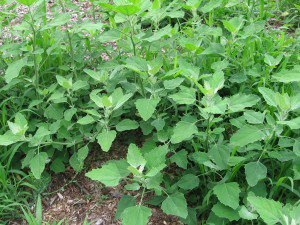Contributing Writer for Wake Up World
Instead of signing over your entire paycheck for organic produce, have you considered the bounty of nourishing fare growing wild right in your own backyard? Not surprisingly, edible weeds have come back into vogue as food prices continue to rise and budgets tighten. Tasty and nutritious, these humble plants ofter exceptional value (as in free) along with substantial health enhancing properties.
Forage and Feast
Weeds are often viewed with a wary eye by gardeners as invasive intruders, not realizing these ‘pests’ are actually a terrific source of low-maintenance, healthy food. We can either wage a full out war against weeds with nasty chemicals along with long hours of backbreaking management, or we can simply consume the robust scoundrels. After all, as Andrea Karim of WiseBread notes, eating the bastards is much more satisfying than trying to fight a losing battle.
Here are few examples to help inspire a bit of backyard foraging this summer.
Purslane
A hearty succulent herb, purslane resembles plump thyme. Leaves, stems, flowers and seeds are edible and can be harvested throughout summer. Add it to salad or soup. It can also be boiled, sauteed or blended into smoothies.
An excellent source of alpha-linolenic acid, purslane provides five times more of this omega-3 fatty acid than spinach. The stems are also high in vitamin C.
Japanese Knotweed
Similar in taste to asparagus and virtually indestructible, Japanese knotweed is a plant to be reckoned with. The tender shoots in springtime are best consumed when the leaves are still furled and the shaft crisp.
Related to buckwheat, “Japanese knotweed is one of the last plants to blossom in late summer – early autumn in New England. Honey bees use its nectar, mixed with goldenrod nectar, to produce a honey as black as motor oil with a strong, distinctive flavor. It’s good for sweetening baked beans and for brewing unusual beers and mead,” according to Tom Meade of Hobby Farms.
It’s also rich in resveratrol, the anti-cancer, neuroprotective and anti-inflammatory nutrient found in the skin of red grapes. Vitamin C levels are impressive too.
Dandelion
Widely consumed throughout Europe, dandelion is just beginning to take a few tentative steps toward the American plate. Bearing in mind this somewhat bitter, yet refreshing green is an outstanding liver and blood cleanser and boasts high levels of vitamin A, a second look at dandelion is in our healthy best interest. The leaves and flowers can be sauteed or consumed raw while roasting and grinding the root produces a nutrient dense, caffeine free coffee substitute.
And more …
Other edible weeds include perilla, mare’s tail, lambs quarter, sheep sorrel, stinging nettle and milkweed.
Foraging for food in your backyard is fun, economical and delicious — just make sure to be safe. Erin Huffstetler, author of Edible Weeds, recommends the following harvesting guidelines:
1. Only harvest weeds that you can positively identify and know to be edible. The Complete Guide to Edible Wild Plants, by the Department of the Army is a good reference, if you aren’t sure.
2. Avoid picking weeds close to roadways. They’ll have absorbed exhaust fumes and road run off.
3. Avoid harvesting weeds in areas that may have been contaminated by animal feces.
4. Do not pick weeds from yards that have been treated with pesticides or herbicides.
5. Only eat the parts of plants that you know to be edible. Many edible plants have non-edible – and sometimes poisonous – parts.
Updated September 2014
Article Sources
http://www.wisebread.com/free-food-in-your-yard-edible-weeds
http://frugalliving.about.com/od/eatforfree/tp/Edible_Weeds
http://www.hobbyfarms.com/crops-and-gardening/edible-weeds
http://www.livescience.com/21496-5-edible-garden-weeds
Previous articles by Carolanne:
- Organic Agriculture Ravaged by Chemtrails: Monsanto Profits and Dominates
- Bipolar Rates Soar Despite Heavy Use of Psychiatric Drugs: Natural Alternatives More Effective
- The Dark Underbelly of Sustainable Development: Agenda 21
- The Ultimate Craving – How Industry Designs Food to be as Addictive as Narcotics
- This is Your Brain on NutraSweet – and it Isn’t Pretty
- Inspiring Urban Farm Grows an Astonishing Three Tons of Produce a Year on a Mere 1/10 Acre
- Discover the Seven Habits of Exceedingly Healthy People
About the author:
I’m Carolanne — a writer, chef, traveler and enthusiastic advocate for sustainability, organics and joyful living. It’s good to have you here. If you would like to learn more, connect with me at Thrive-Living.net or visit Twitter.com/Thrive_Living.

If you've ever found value in our articles, we'd greatly appreciate your support by purchasing Mindful Meditation Techniques for Kids - A Practical Guide for Adults to Empower Kids with the Gift of Inner Peace and Resilience for Life.
In the spirit of mindfulness, we encourage you to choose the paperback version. Delve into its pages away from screen glare and notifications, allowing yourself to fully immerse in the transformative practices within. The physical book enriches the learning process and serves as a tangible commitment to mindfulness, easily shared among family and friends.
Over the past few years, Wake Up World has faced significant online censorship, impacting our financial ability to stay online. Instead of soliciting donations, we're exploring win-win solutions with our readers to remain financially viable. Moving into book publishing, we hope to secure ongoing funds to continue our mission. With over 8,500 articles published in the past 13 years, we are committed to keeping our content free and accessible to everyone, without resorting to a paywall.








